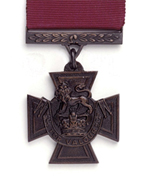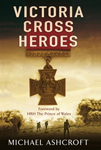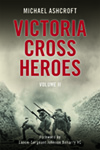About the Victoria Cross
The Victoria Cross (VC) is the highest decoration awarded for valour “in the face of the enemy” to the Armed Forces of Britain and other Commonwealth countries. The decoration can be awarded to a person of any rank in any service and also to civilians under military command. The VC takes precedence over all other orders, decorations and medals.
The VC was established by a Royal Warrant on 29 January 1856 that announced the creation of a single decoration available to the British Army and the Royal Navy. It was intended to reward ‘individual instances of merit and valour’ and which ‘we are desirous should be highly prized and eagerly sought after’. The warrant laid down fifteen ‘rules and ordinances’ that had to be ‘inviolably observed and kept’.
The origins of the VC lay in the Crimean War: the notion of giving a bravery award to low-ranking soldiers and sailors first came under serious consideration in 1854. Until that point, neither the government nor its military leaders had felt the need to reward ‘ordinary’ men for their courage. However, after nearly forty years of peace, Britain found itself embroiled in a major war against Russia and, from the earliest days of the conflict, stories began to circulate of the outstanding bravery of the British Army in the most appalling conditions. These heroics moreover were being performed in spite of an appalling a lack of adequate clothing and other basic equipment to protect the men from the harsh Russian winter.
need to reward ‘ordinary’ men for their courage. However, after nearly forty years of peace, Britain found itself embroiled in a major war against Russia and, from the earliest days of the conflict, stories began to circulate of the outstanding bravery of the British Army in the most appalling conditions. These heroics moreover were being performed in spite of an appalling a lack of adequate clothing and other basic equipment to protect the men from the harsh Russian winter.
Until the Crimean War, officers – usually majors and above – were often given the junior grade of the Order of the Bath for acts of bravery. However, there was no such equivalent medal for junior officers or non-commissioned officers (NCOs), let alone ordinary soldiers, or sailors. In Britain, though, there was a growing feeling that a new award was needed to recognise examples of gallantry irrespective of a man’s lengthy or meritorious service. Both Queen Victoria and Prince Albert were enthusiastic about addressing the problem, particularly as the enemy, Russia, already had awards for gallantry that ignored rank. Queen Victoria herself eventually chose the design of the medal, and its famous inscription: ‘For Valour’. It was more than a year after the Royal Warrant was signed that the first awards of the VC were published in the London Gazette on 24 February 1857. The Queen made it clear that she wished to bestow as many of the awards as possible herself and so, on 26 June, she invested 62 of the 111 Crimean recipients in a ceremony in Hyde Park, London.
Over the years, there have been several significant amendments to the original 15 rules but the basic principle – that the award is for conspicuous bravery – has remained to this day. Since 1857, the decoration has been bestowed 1,364 times to 1,361 individual recipients (three recipients have also received a ‘Bar’, or second VC).
* For a longer account of Lord Ashcroft’s early interest in bravery read his books,
Victoria Cross Heroes, Volume 1 and Victoria Cross Heroes, Volume 2.

